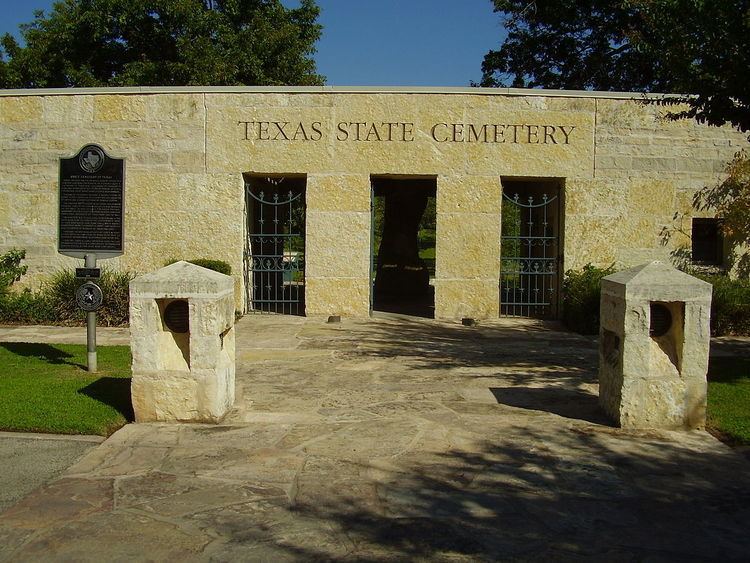Year built 1851 Added to NRHP 12 May 1986 | NRHP Reference # 86001085 Phone +1 512-463-0605 | |
 | ||
Address 909 Navasota St, Austin, TX 78702, USA Hours Closed now Wednesday8AM–5PMThursday8AM–5PMFriday(Cesar Chavez Day)8AM–5PMHours might differSaturday8AM–5PMSunday8AM–5PMMonday8AM–5PMTuesday8AM–5PMSuggest an edit Similar Bullock Texas State Hist, General Land Office Building, Oakwood Cemetery, Texas Governor's Mansion, French Legation Profiles | ||
George w bush s burial plot in texas state cemetery
The Texas State Cemetery (TSC) is a cemetery located on about 22 acres (8.9 ha) just east of downtown Austin, the capital of the U.S. state of Texas. Originally the burial place of Edward Burleson, Texas Revolutionary general and Vice-President of the Republic of Texas, it was expanded into a Confederate cemetery during the Civil War. Later it was expanded again to include the graves and cenotaphs of prominent Texans and their spouses.
Contents
- George w bush s burial plot in texas state cemetery
- Chris kyle buried in texas state cemetery
- Burial guidelines
- History
- Statistics
- Popular culture
- References
The cemetery is divided into two sections. The smaller one contains around 900 graves of prominent Texans, while the larger has over 2,000 marked graves of Confederate veterans and widows. There is room for 7,500 interments; the cemetery is about half full, after including plots chosen by people who are eligible for burial.
Chris kyle buried in texas state cemetery
Burial guidelines
The guidelines on who may be buried within the Texas State Cemetery were first established in 1953, and are currently set by Texas state law. Currently, all persons to be buried in the cemetery must be one of the following:
History
After the death of Edward Burleson in 1851, the Texas Legislature arranged for his burial on land formerly belonging to Andrew Jackson Hamilton. In 1854, the Legislature established a monument at Burleson's grave-site for $1,000 and purchased the surrounding land. The burial ground was virtually ignored until the Civil War, when Texas Confederate officers killed in battle were buried there. In 1864 and 1866 more land was purchased for veterans' burials. An area of 1-acre (4,000 m2) was also set aside for graves of Union veterans (all but one later removed, to Fort Sam Houston National Cemetery in San Antonio). The remaining Union soldier is Antonio Briones, who was left at the request of his family. He is interred alone in the far northwest corner of the cemetery.
Because the Texas Confederate Men's Home and the Confederate Women's Home were located in Austin, more than two thousand Confederate veterans and widows are interred at the State Cemetery. Most were buried after 1889. The last Confederate veterans in the Cemetery were reinterred in 1944; the last widow, in 1963.
In 1932, the State Cemetery was little known and had no roads. There was a dirt road running through the grounds of the Cemetery linked to what was then called Onion Creek Highway. The road kept its highway status when Texas historian Louis Kemp brought it to the attention of the Texas Highway Department that the road running through the Cemetery should be paved. The roads, which are officially designated as State Highway 165, are dedicated to Kemp, and were for a time known as "Lou Kemp Highway". Kemp was also the driving force behind the reinterment of many early Texas figures in time for the Texas Centennial in 1936.
The cemetery was added to the National Register of Historic Places in 1986, but by the early 1990s, the State Cemetery had fallen into disrepair—suffering from vandalism and decay—and was unsafe to visit. In 1994, after noting the condition of the Cemetery, Lieutenant Governor Bob Bullock initiated a three-year project that added a visitor center and renovated the cemetery. In 1997, there was a re-dedication and a reopening of the State Cemetery.
A three-person Texas State Cemetery committee oversees operations at the cemetery. Benjamin M. Hanson (appointed by Governor Greg Abbott) is chairman. James L. Bayless (Speaker's appointment) and Carloyn Hodges (appointee of the lieutenant governor) also serve. The cemetery superintendent is Harry Bradley. The senior historian is Will Erwin and the head of the research department is Jason Walker.
Former Governor and United States President George W. Bush announced his intention to be buried in the State Cemetery.
Statistics
As of 2016, buried in the Texas State Cemetery are:
